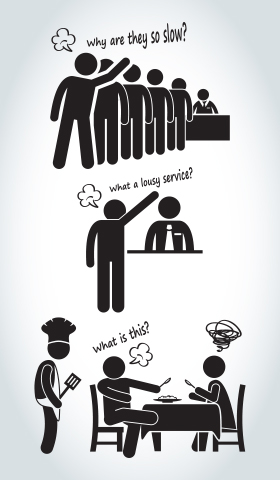
Have you ever brought up a grouse over food in the restaurant but was told, “it’s the way we do it” without even acknowledging your comment? Such cases are subjective as the restaurateur does stand to defend its food but knowing good customer service would dictate the manager to listen and provide a diplomatic explanation – most people would appreciate just being heard. Something small on the house won’t hurt to make them feel better. That’s one of the many things customers complain about, including:
• Waiting too long for a table/the food/the bill
• Wrong/forgotten orders
• Rude servers
• Hygiene
• Servers not bringing water immediately
• Feeling rushed to leave
We once ate at a restaurant where free cakes were given on birthdays. Neither of us were in our birthday zone but we took a chance and asked if it was possible to fete our occasion of celebrating a 20-year-old friendship with a cake. The manager gladly obliged and while I do not necessarily like the food, the good service definitely scored points.
In the service line, “customer is king”is the general sentiment that most service providers operate on. Of course there are exceptions but customers’ complaints are typically solvable with the right mindset, training and execution.

WHEN COMPLAINTS COME
Actually, “A lot of customers don’t like to complain,” (Doug Brown,“The Restaurant Manager’s Handbook”) “A lot of people will just not come back and never say why.” However, complaints serve to help a business improve and should be looked upon in good light. Restaurant veteran John Isbell of Logan’s Roadhouse loves guest complaints. “It means the guest likes you enough to give you a chance to fix the situation,” and from Mike Lester (The Melting Pot) saying each complaint is “a gift”. “It is a second chance to earn our guest’s business back.” What are some of the tried-and-tested ways to manage common issues that arise during operations?
• Waiting Too Long
15-minutes would be acceptable for most guests, especially if it is crowded. It tends to be a non-issue in a long established eatery as customers already expect it. However, in a newly-opened place, many owners get over whelmed by eager beavers and have trouble keeping up.
Solution: Have a “doorkeeper” to constantly update the customer on the wait status. A free drink or snack works to appease them as well. It helps them feel taken care of and helps manage their expectations. You could even offer vouchers for their next visit if the guests can no longer wait and advise them to make a reservation ahead of time.
• Wrong/Forgotten Orders
Back in the age of pen-and-paper, mistakes are apt to happen but in today’s electronic POS age, it still happens. Simply because your server is human and they might key in the wrong item or there is a miscommunication between the front and kitchen resulting in the mistake. Or it could be a very busy day and you are understaffed.
Solution: It is as simple as following up on the order and communicating the urgency to the kitchen. Or bringing the food back and ensuring the guests gets the correct one. However, a server should also be sensitive to timing and not let the customer wait too long for the replacement to prevent triggering more displeasure.
• Unsatisfactory Food
The cold pasta to person A may not be an issue to person B or most of the customer base but you are to take each person complaint with respect to the guest.
Solution: Listen to the customer, acknowledge the concern and if possible, you could explain why the dish is done this way and perhaps it was a little bit off today. Give the customer an option to have it replaced or have a new item on the menu. It definitely helps to waive the item off the bill. However, should the complaint be a recurrent one from different guests such as the bun is too soggy / hard, the rice is tasteless or too spicy…then it is time to return to the kitchen for quality inspection.
• Unexpected Requests
Once, a group of us visited a famous chain restaurant and found that we were a few days too early to redeem the birthday gift. We asked the manager if she could still give it to us since we purposely made the trip there; and to make a note to her management to backdate the redemption record. She said it cannot be done. We even offered to pay for the novelty of the gift but it was denied as well. It can be understood that the manager might be uncertain about going against regulations but she wasn’t too pleasant in explaining either.
Solution: In the above mentioned; explaining your policies would be helpful instead of just maintaining a “it cannot be done” stance. Clarification helps people put things into perspective.
BETTER MANAGEMENT, BETTER OUTCOMES
Regardless of the situation, there are key actions that should be in your SOP of customer service management which will help your team be more engaging so that the customers will leave with something positive despite the upsetting incident.
 • Apologise: It helps to begin with an apology, no matter what the scenario. It does not mean you are admitting to the problem (as some issues probably aren’t your fault) but it demonstrates that you understand the customer’s frustration and endeavour to provide a solution. Most of the time, it calms them down and gets them to be more open to accept solutions.
• Apologise: It helps to begin with an apology, no matter what the scenario. It does not mean you are admitting to the problem (as some issues probably aren’t your fault) but it demonstrates that you understand the customer’s frustration and endeavour to provide a solution. Most of the time, it calms them down and gets them to be more open to accept solutions.
• Listen, Empathize & Ask: Many people hear but do not listen. Keep in mind to let the customer completely finish talking before jumping in with your conclusion/assumption. When you put yourself in the customer’s seat, you are empathizing and can understand why the customer is unhappy in order to effectively handle the situation. Ask for more information or rephrase their statement to make sure that you have understood correctly. If he/she does not know what they want to achieve out of the complaint, you could ask what is an acceptable solution or suggest a few compensatory gestures they can choose from.
• Body Language: This may betray your words as people can pick up your true feelings by observing body language. Always maintain eye contact and never roll your eyes (no matter how unreasonable the complaint sounds to you), keep an “open” body position and do not cross your arms as this shows defensiveness. Nodding and smiling indicates to the guest you are listening.
• Quick Resolution: Try not to pass the issue to someone else as it makes the customer frustrated to repeat himself. An ideal setting is to give employees the autonomy of a certain level to handle customer disputes and know when to bring in the manager if they cannot cope.
In an industry where people are instrumental in either making or breaking your business, customer service is therefore vital particularly in situations that demand an immediate response. Imagine in a restaurant filled with people and the front-of-house is seen poorly managing a customer’s complaints, what does it show the rest of the floor? Remember, a dissatisfied customer tell between 9-15 people about their experience and about 13% of them end up telling more than 20 people. Comparatively, a happy client who had their issue resolved only tell 4-6 people about it. (White House Office of Consumer Affairs). In today’s landscape, you must also contend with the power of social media’s reach. It is no longer a time where if customer does not speak up, it won’t be told elsewhere. And if it takes 12 positive experiences to make up for 1 unresolved negative experience, wouldn’t you place more emphasis on polishing up your customer service?
References:
• https://pos.toasttab.com/blog/common-customercomplaints-social-media
• https://www.thebalance.com/how-to-handle-customercomplaints-2888421
• http://www.restaurant.org/Manage-My-Restaurant/Workforce-Management/Training/The-art-of-handlingguest-complaints
• https://restaurantengine.com/handle-customer-disputes/
• “Understanding Customers” by Ruby Newell-Legner.










